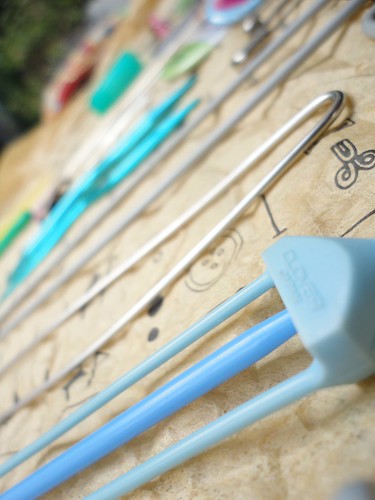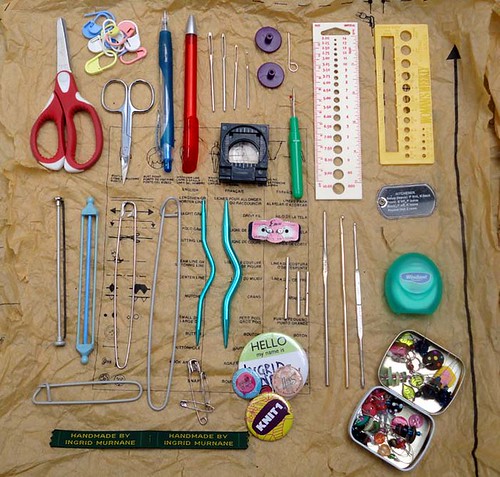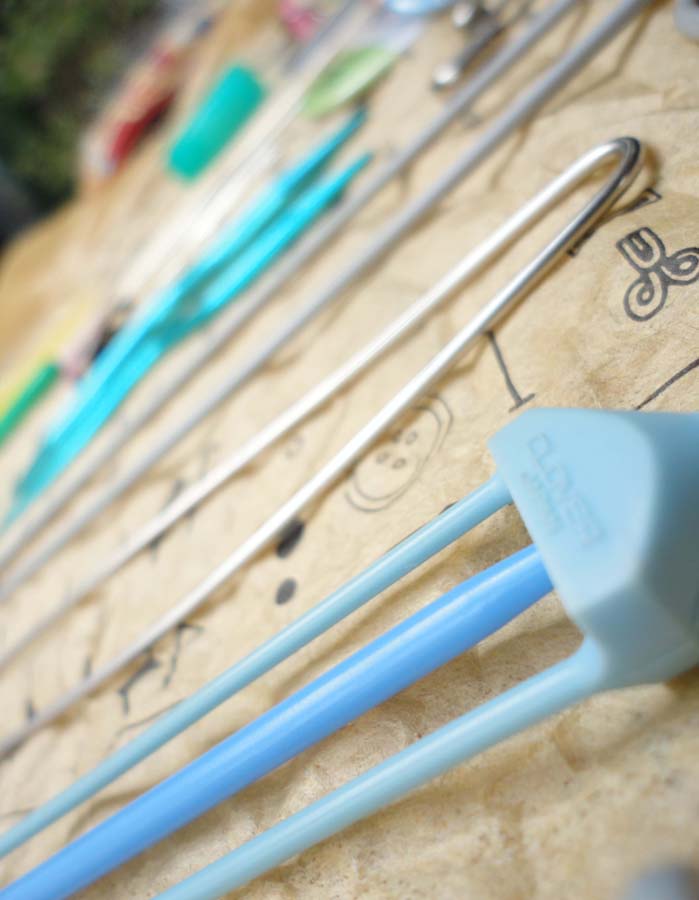I like stitch holders a lot – they’re an incredibly useful piece of kit. I must admit that I especially like the ones that look like a really big safety pin. Those, probably because of the connotations of their name, seem to me to do the best job of keeping the live stitches from unravelling while I’m working on another piece of my knitting (this is really not the case and all in my head, but humour me).

If you’re new to stitch holders, they do exactly what it says on the tin. When a pattern tells you to put the stitches on a piece of waste yarn instead of casting off, you can use a stitch holder at that point. The reasons for not needing a bound off edge might be because for instance, you are working on a jumper that will have a neckband or collar knitted once all of the main parts have been sewn together, using the live stitches at the tops of the front, backs and arms. Using a stitch holder will stop them from unravelling until you need to do that next bit.
Stitch holders come in a variety of shapes and sizes and today are generally made from metal or plastic. A knitter from the 1920s to the ’80s, my grandmother used commercial ones made of metal, or earlier, home-made ones using a crochet hook with elastic attached. Her mother thought these were an extravagance and used a piece of waste yarn, always.

There’s a good point to be made here about how many stitches to try and get on the stitch holder without the catch popping and all of your lovely knitting busting free. Always use a stitch holder that is large enough for the amount of stitches that you need to hold. Simple logic, I know, but it is very tempting to try and shove more and more stitches on, as if they were scouts trying to cram into a mini on Record Breakers.

So if you do have a very large amount of stitches, it might indeed be better to thread a long piece of contrasting yarn through the live stitches instead (fastening the two ends together by tying a knot), although there are alternative ways too. You’ll find this sort of instruction in particular when knitting things such as a top down garment. The pattern will often ask you to put the stitches on hold after dividing for the sleeves while you knit the main body. In this instance, with a large amount of stitches to be held in the round you can make use of your vast collection of 29 stitch holders all put in a row, of course, use a piece of waste yarn, or if you have a set of interchangeable circular needles, you can take off the needle ends and twist on the end stops until you need those stitches again. End stops: so newfangled. My own grandmother wouldn’t approve of this at all as she thought circular needles entirely odd and unneccesary.

If not a big garment knitter, you might have come across the same sort of stitch-holding instructions when making gloves or mittens. If knitted in the round, the thumb stitches will often be held while the rest of the hand is knitted. If knitted flat, you might hold the live stitches at the top of the palm and back of the hand while the fingers are knitted one by one. For flat-knit gloves, stitch holders work a treat for this type of holding, but not so much for the thumbs. The reason being, which I have learned the hard way, that the thumb stitches number few and need to be kept in the round for fear of stretching the stitches, the straight holder getting in your way, or your cat chewing on the stitch holder while you carry on knitting and it jogs about in an oh-so-tempting manner. None of which are preferable. The answer, of course as I’m sure you’re thinking is to put these live stitches on a piece of waste yarn. Well yes indeed you might, and it would work fine, but there is another way too. A piece of wire also works brilliantly in these situations, as it can be flexed and held in shape. The added bonus here for cat owners is that the ends of the waste yarn are not available for stealth attacks.

For even smaller situations, such as holding one singular stitch (it does happen!) you can use an actual safety pin, or if you’re fancy and have removable stitch markers that open you can use those too. It might be tempting to use a cable needle here, as the one-stitch-hold generally involves knitting a bit more before picking up that stitch again, it gives ample time for the stitch to stretch and/or the needle to drop out and your knitting to unravel. Don’t say I didn’t warn you!
On that last note, I always wondered whether Liz Hurley was a knitter. That Dress was such a handy way of keeping your safety pin stitch holders nearby in case of emergencies in the same way as using an earring as a stitch marker.
All images used in this post that are not my own are used under
c license.
lili
c

